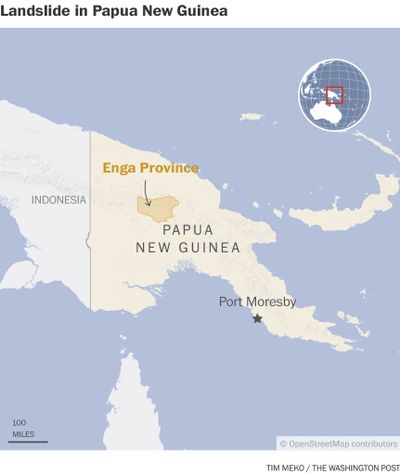Papua New Guinea struggles to find estimated 670 killed in landslide

About 670 people – many of whom are feared to be children – are assumed dead after a landslide deluged several villages in Papua New Guinea on Friday, according to the U.N. International Organization for Migration.
Local officials extrapolated the estimate based on the number of homes – more than 150 – that were buried in the northern Enga province, said Serhan Aktoprak, the chief of the U.N. migration agency’s mission to the Pacific nation north of Australia.
Bodies of most of the presumed dead have not been found, and the full extent of the disaster is still unclear.
The search and rescue mission has been complicated by the after effects of the landslide, including unstable debris, and tribal warfare. Conditions in the area Sunday night local time were still threatening rescue workers and residents, who are mostly subsistence farmers.
“Land is still sliding, rocks are falling, ground soil is cracking due to constant increased pressure, and ground water is running,” Aktoprak told the Washington Post from Port Moresby, the capital of Papua New Guinea.
At least 1,250 people have been internally displaced since Friday. Most have found shelter with friends or relatives, Aktoprak said.
An elementary school, small businesses and stalls, and a gas station are buried. Porgera Highway, the only way to reach the nearby Porgera gold mine, has also been cut off.
Although a detailed investigation into what triggered the landslide is pending, some members of the Tulpar community told the International Organization for Migration (IOM) that lightning hit a nearby mountain, loosened the ground and precipitated the landslide. Others said heavy rainfall over the past month probably loosened the ground.
The footprint of the landslide – which includes the source area and the deposits – is about 915,000 square feet, said Kate Allstadt, a research geophysicist who studies natural hazards for the United States Geological Survey.
Allstadt analyzed satellite imagery from last year and found that the slope was unstable because of a previous landslide.
David Lipset, an anthropology professor at the University of Minnesota Twin Cities, said the rural area was vulnerable because homes were made of locally sourced materials.
“But with a landslide of this size, I don’t know what kind of construction would’ve reduced the death toll.”
The main community affected by the landslide is the Tulpar, according to an email from Aktoprak.
In recent months, Enga province has seen deadly clashes between tribal groups.
The Tulpar community is internally displaced because of these clashes; it sought shelter in Yambali village at the foot of the Mungalo mountain “after escaping tribal conflict from elsewhere,” Aktoprak said.
He added that the community is a young one, and he fears most of the dead are children under 15.
The high death toll could also be attributed to the ongoing infighting and the displacement it has caused, researchers said.
“Enga is already suffering from warfare between different groups, and one impacted group from further east recently moved to the where the landslide occurred,” said Dan Jorgensen, an anthropology professor emeritus at Western University in Canada. “That may account for why the number of victims was higher that it would have normally been.”
Jorgensen added that the warring factions were setting up roadblocks, delaying the delivery of relief to survivors.
The recovery, data-collection and excavation process has been difficult, said the email from the IOM, which set up an aid site in the Yambali village.
In the day after the landslide, the government was approaching the community only to offer condolences because it would have been “insensitive and inappropriate to start collecting data on the dead at this particular point in time when people are mourning.”
President Joe Biden said Friday that the United States was ready to aid in rescue and recovery efforts. Australian Foreign Minister Penny Wong also said in a statement that her country would respond to assistance requests.
Five bodies had been recovered by Sunday, Aktoprak’s email said.
By then, humanitarian convoys and military crews had arrived in Wabag, the provincial capital, to help distribute food, water and other essentials.
“People are using digging sticks, spades, large agricultural forks to remove the bodies buried under the soil,” he said. A local businessman has offered an excavator to help, Aktoprak said, but “the community may not allow them to start operating (heavy machinery) until they consider they fulfilled their mourning and grieving obligations.”
Aktoprak said mourning can last up to a week for a single death; for a mass event like this, it could be a month.
“Government may request the community to shorten mourning for the section of the landslide that blocks the Porgera Highway,” Aktoprak said, but even then the “community may not permit any machinery to enter sections of the village where the Tulpar community remains under the debris.”
- – -
Graphic: https://washingtonpost.com/documents/762bb114-f924-47b2-a781-88e1392f5eeb.pdf